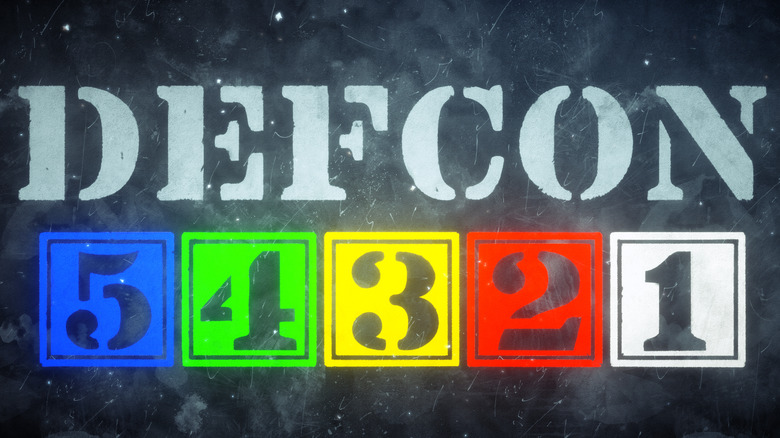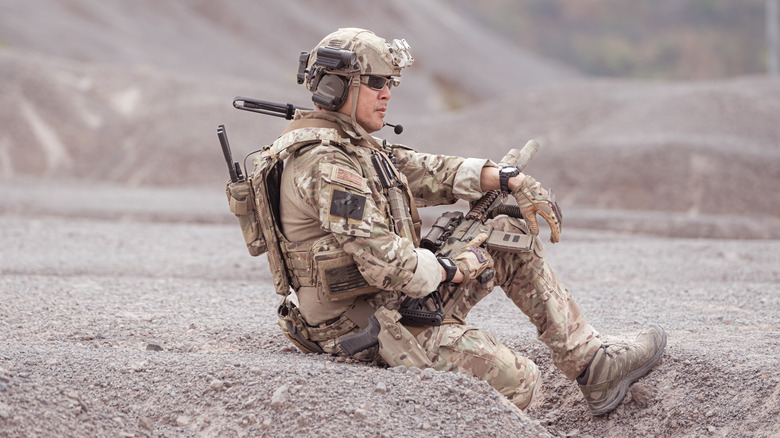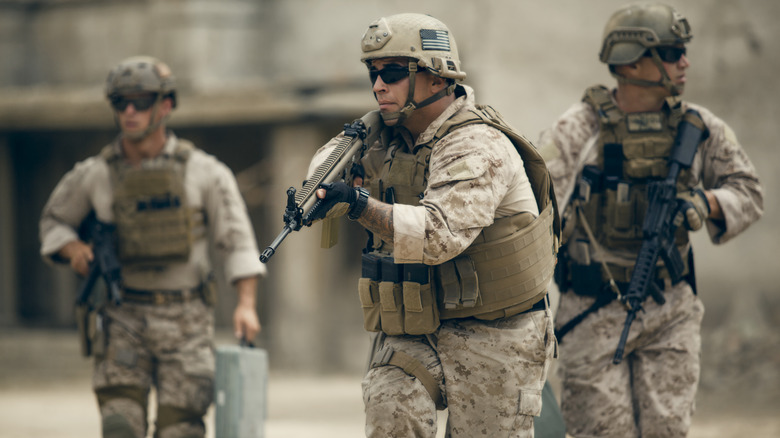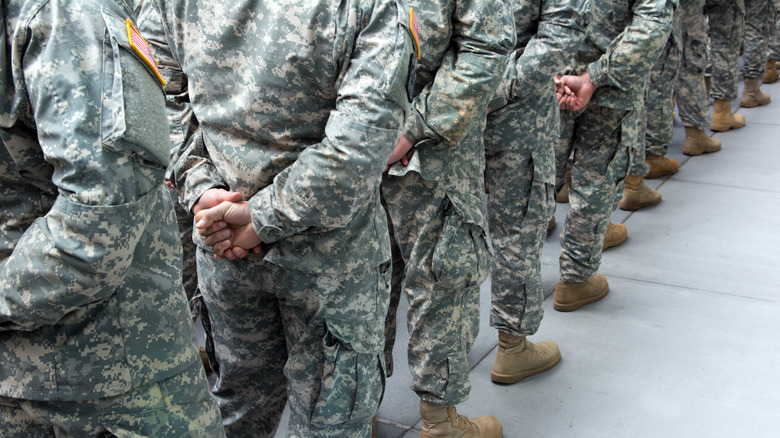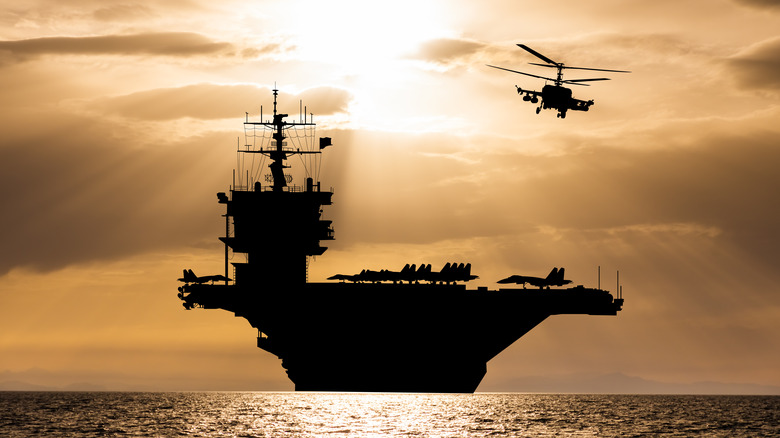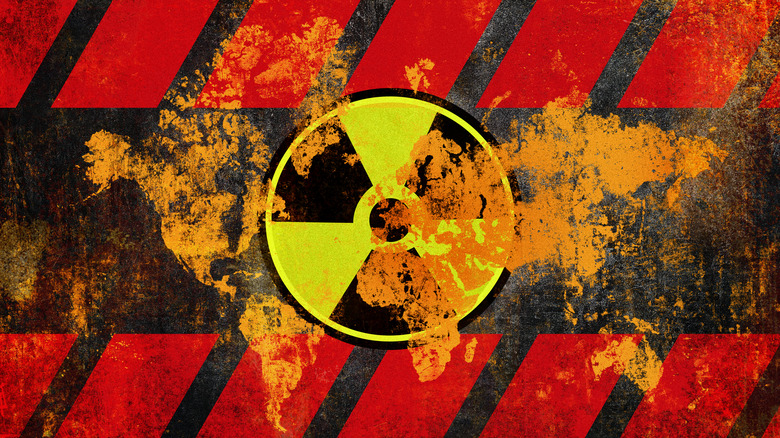DEFCON Levels Explained: What Each Stage Means For The US Military
If you've ever watched a movie about modern warfare, you've probably heard the term "DEFCON" thrown around. Some kind of suited authority figure dramatically says, "We're at DEFCON 1!" accompanied by an equally dramatic musical sting. And despite how frequently the term gets thrown around in military fiction, DEFCON is a very real term — one of the most important quantifiers of United States national security.
DEFCON is short for "Defense Condition," a term coined during the Cold War as a shorthand for how ready the U.S. currently is for armed warfare. The DEFCON level is always being monitored and changed based on the current geopolitical climate, though in the interest of public stability, the current level is never openly broadcasted. Unless you work in a government or military position, the odds of you knowing — or needing to know — the DEFCON level is low. Still, let's go over what each of the five levels of this system refer to.
DEFCON 5: Everything's fine
DEFCON 5 is the lowest, and default, DEFCON level. If everything's just fine for the United States and nobody's looking to pick a fight with the country or its allies, the nation is at DEFCON 5. Every DEFCON level has a short code name for exercise purposes — DEFCON 5's code name is "Fade Out."
When at DEFCON 5, the U.S. military is at its default state of readiness. No one's getting ready for armed conflict or serious missions, there's just training exercises and basic equipping. This is the equilibrium state between complete peacetime and wartime readiness — the military isn't just sitting on its proverbial laurels, but there are no plans to engage in armed conflict with any other nations, nor are there any assumptions that armed conflict is in the immediate future. Soldiers can be quickly prepped for a conflict should the need arise, but until the need does arise, they're simply doing their best to stay focused and in shape — just in case.
DEFCON 4: Getting ready, but nothing's actually happening
DEFCON 4 is, obviously, one step above default peacetime. The code name for DEFCON 4 is "Double Take" — the kind of situation that makes you say "Wait a minute" and look at something again more closely. When in DEFCON 4, there's still no conflict going on, but there is something suspicious or unusual affecting American interests and/or safety. This could be some manner of wide-scale instability at America's borders, or similar problems occurring with one of America's close allies.
In DEFCON 4, subtlety is the name of the game. The government will expand intelligence-gathering operations to get a better picture of what, exactly, is causing this supposed instability, and more importantly, whether it's something to actually be concerned about. For similar purposes, greater scrutiny is placed on the political and military situations surrounding the area of instabilit. The military, meanwhile, places a slightly greater emphasis on security. No one's expecting armed intervention to be necessary at this point, but troops are on standby to deploy and defend U.S. interests, just in case.
DEFCON 3: Ready for action
DEFCON 3 is the highest DEFCON level America can reach while still technically being in peacetime. The country isn't quite at armed conflict yet, but at this point, the matter has started to become serious. The code name for DEFCON 3 is "Round House." The DEFCON level is raised to 3 if there is a chance of an attack coming, but it hasn't yet been 100% confirmed.
Whatever it is that's happening to the U.S. or its allies, there is a distinct chance it will require an armed intervention. Regional tensions have escalated to the point that the problem may not have a diplomatic solution. The problem may not be there yet, but U.S. troops need to be at a higher level of readiness in case something does happen. Any troops that are on leave or otherwise not in a prepared state need to immediately return to their units and get ready.
DEFCON 2: One step from war
If some manner of upcoming attack by a hostile foreign entity has been nearly confirmed, the danger level is raised to DEFCON 2. At this point, either the U.S. or its allies are under serious threat of harm. The code name for DEFCON 2 is "Fast Pace," likely because once it's made clear that armed conflict is coming, all relevant personnel in the U.S. government and military are going to need to move fast to address and, hopefully, prevent the worst-case scenario.
At DEFCON 2, the military is at a level of readiness one notch below the maximum. Soldiers have been armed and organized, fast fighter jets are waiting on runways to fly to the scene, and submarines are floating in the ocean, ready to launch missiles if need be. Should the order come down from on high, all sections of the armed forces will immediately mobilize to the area of disturbance.
If necessary, there may be action on the civilian level in the interest of keeping U.S. citizens safe from harm. One of the only times the United States ever reached DEFCON 2 was the Cuban Missile Crisis of 1962, when President John F. Kennedy went on TV to warn the nation that there was a high chance of thermonuclear war. War was averted at the last minute when the Soviet Union removed its missiles from Cuba and the U.S. pledged not to invade the island nation.
DEFCON 1: Full-blown conflict
Should the absolute worst come to pass, the DEFCON level will be raised to its maximum level: DEFCON 1. The code name for DEFCON 1 is "Cocked Pistol," the reason for which should be obvious: the United States has entered into full-scale armed conflict with a hostile foreign entity. The military is in its maximum state of readiness and is set to immediately respond to deployment orders for combat. War has broken out, with attacks from hostile entities against the U.S. or its allies either imminent or already in progress.
As the DEFCON system was established during the Cold War and rising concerns of nuclear warfare, the rise to DEFCON 1 comes with an implication that nuclear weapons may be employed on both sides. In such a circumstance, civilian life would almost definitely be affected.
It's difficult to say whether that implication remains as strong as it used to, as the United States has never actually reached DEFCON 1, at least as far as the public has been informed. Since the founding of the DEFCON system, the U.S. has never reached full country-on-country nuclear war status, though the Nuclear Triad ensures America is ready to respond if necessary.
